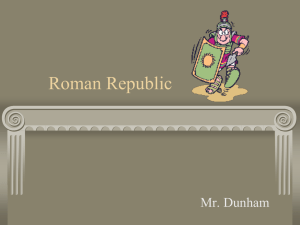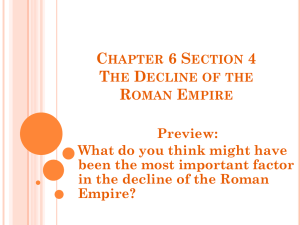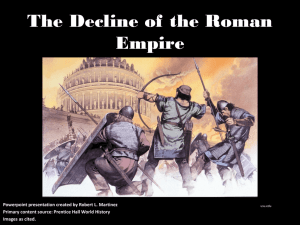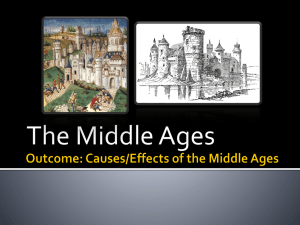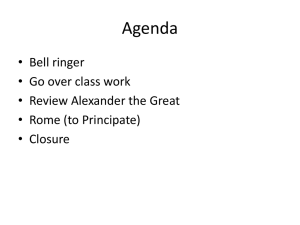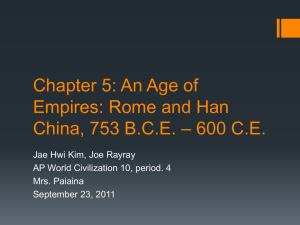Rome PPT
advertisement
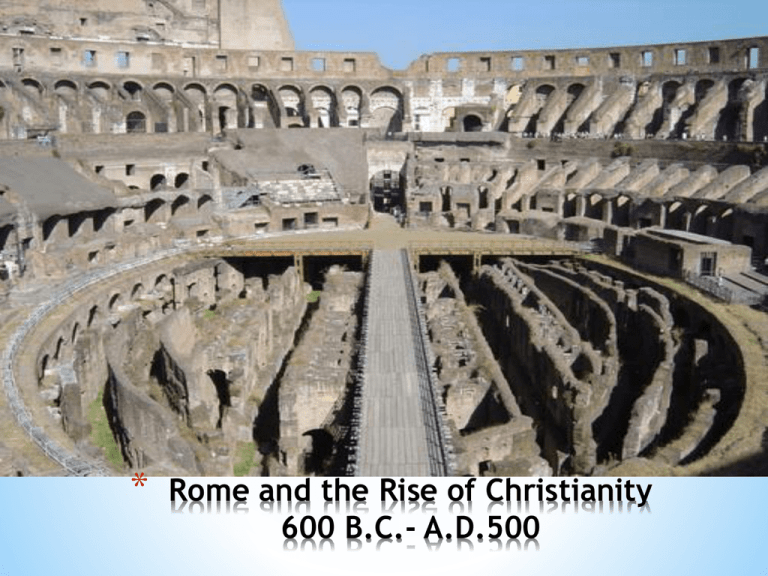
* Rome and the Rise of Christianity 600 B.C.- A.D.500 • How did geography effect the development of Rome? • How did Rome develop a republic? • How did the Punic Wars effect Rome? • Describe Roman government. • What were problems in the Republic? * How did Rome spread its power? * How did Rome become an empire? * What were problems in the Roman Empire? * List Roman contributions to Western Civilization. * Explain the rise of Christianity during Roman rule. * What led to Rome becoming an Empire? * Describe the decline of the Roman Empire. * * * * * * * * * * * * * * * * * * * * * * * * * * Latins Etruscans Republic Senate Council of Plebes Tribune of Plebes Twelve Tables Law of Nations Hannibal Triumvirate legions Imperator Julius Caesar Augustus Pax Romana Procurator New Testament Simon Peter Paul Constantine Theodosius the Great Diocletian Constantine Huns Vandals * * Italy is on a peninsula divided by a mountain range (Apennines), and has large fertile plains that are good for farming * Mountains are less rugged than Greece and good farmland supported a larger population * Two major rivers are the Po in northern Italy and the Tiber that ran through the city of Rome * Italian peninsula is centrally located on the Mediterranean Sea, it allowed Rome to become a cultural crossroads * From 1000 B.C. to 500 B.C. three groups inhabited region- Latins, Greeks, Etruscans * Latins built the original settlement of Rome * Greeks established colonies along coast of Italy and Sicily, brought Rome into contact with Greek culture, taught Romans to grow grapes and olives * Romans borrowed religious ideas, system of writing and engineering techniques from the Etruscans * * Romans got rid of Etruscan king in 509 B.C. and established a republic (leader is not a monarch, certain citizens have a right to vote) * Over the next 100 years Romans took control of the peninsula * Rule of Italy called the Roman Confederation made many people full citizens, let local communities run their own affairs Why Romans were successful •Romans were skilled diplomats, gave conquered people a stake in Rome's success •Law and politics were designed to respond to problems •Rome had a skilled army, they built roads and fortified towns that allowed troops to move quickly * * Early Rome divided onto two groups that competed for power patricians, plebeians * * Patricians –large land owners became ruling class Plebeians- small farmers, larger group * Men of both groups were allowed to vote and were * * * * * * * * citizens Chief officers of Republic were Consuls, Praetors Consuls ran the government, led Roman army Praetors were in charge of civil law Senate- 300 members from the patrician class, advised government officials, membership for life, very influential Struggle between plebeians and patricians led to the development of council of plebes, officials were called the tribune of the plebes The Roman system of law has influenced legal systems in modern times Rome’s first code of laws was the Twelve Tables it protected citizens and was an advanced form of civil law and established that all people had equal protection under the law As Rome began to expand new laws established called the Law of Nations that applied to Romans and non Romans that standardized justice and equality * * All citizens that owned land required to serve in military * Solider organized into large units called legions * Calvary supported each legion * Legions were self sufficient and did their own construction of roads and bridges * Roman military organization and skill were key to the rise of Rome * Conquered people were given some rights like full Roman citizens, some were left alone as long as they paid taxes and provided soldiers for the army * * * After Romans conquered Italy they had another threat to deal with – Carthage * Carthage had been founded by the Phoenicians on the North Coast of Africa, they were a trading empire * Empire included North Africa, Spain, Sardinia, Corsica and western Sicily * Largest and richest state in the area * 246 B.C. Rome and Carthage began a struggle for control of the region-Western Mediterranean * First Punic War- started in 264 B.C. Rome and Carthage fought over Sicily. Romans had to build a navy to defeat the Carthaginians. 241 B.C. Carthage gives up all rights to Sicily. * Carthage wants revenge. Carthage added new lands in Spain and the Romans encouraged a revolt against Carthage. Carthaginian General Hannibal is sent to attack Rome * Second Punic War- 218 B.C. Carthage attacked Rome Hannibal came across the Alps with a huge army. Defeated the Romans. Rome recovered and by 206 B.C. Romans defeated Carthage and pushed them out of Spain * Third Punic War- 146 B.C. Romans invade Carthage, burn it down and destroy all buildings. All citizens were sold into slavery and Carthage becomes a Roman province * Results of the Punic Wars- gave Rome control of the Mediterranean and allowed them to be the regions’ most powerful state * * * Second Century Senate was the most powerful political force, it was controlled by a small group of wealthy powerful families. * Many wealthy landowners had slaves that worked on their farms, small farmers could not compete and they were bought out by large land owners, small farmers drifted to the city * There was a growing gap between rich and poor * Gracchus brothers were aristocrats that tried to pass land reform laws, giving land to landless poor * Both brothers were assassinated because they were seen as a threat to the Senates power. (133 B.C., 121 B.C.) * Their attempts at reform showed the instability of the Roman government * Political struggle in Rome was between the Senate, the military and the popular assemblies * *Army started recruiting soldiers from the landless poor by promising them land. *Soldiers fought for pay and owed their allegiance to their commander. They replaced citizen soldiers who fought for the republic *Military commanders could now use the army to take over by force *Civil Wars and slave uprisings were common in Rome in the first century B.C. *Ambitious leader Julius Caesar took control and for the next ten years Rome was ruled by three political leaders (Caesar, Crassus, Pompey) known as the Triumvirate (three rulers with equal power) * * * Caesar was a brilliant military commander and in 59 B.C. he conquered Gaul, modern day France, in a ten year campaign * These conquests made him popular with Romans. Pompey jealous of his success ordered him back to Rome * Caesar took his army back to Rome and attacked Pompey’s forces. They fought a three year war across the western Mediterranean * In 46 B.C. Caesar returned to rule Rome * Caesar gave citizenship to many in Rome’s provinces, launched public works program, introduced a new calendar based on Egyptian knowledge (Julian calendar, still in use today) * 44 B.C named emperor for life * Caesars enemies were worried about growing power. March 15, 44 B.C. Caesar was assassinated in the Roman Senate * After the death of Caesar their was a struggle for power between Marc Antony and Caesar’s great nephew Octavian over who would hold power * Octavian defeated Antony and became ruler of Rome and took the title Augustus * He named himself princeps, first citizen, he became an absolute ruler * Augustus reigned from 31 B.C. to 14 A.D. and was the most capable leader: he stabilized the government, ended the civil wars, glorified Rome and created a system of government that lasted for centuries * * * Augustus proclaimed the restoration of the Republic, but he only gave the senate limited power, became Rome's first emperor * Army was chief source of power, only citizens could serve in the army * Stabilized Rome’s frontiers and conquered new areas * Established the praetorian guard to protect the emperor * Augustus’ reign began a period known as the Pax Romana that lasted from 27 B.C. until A.D. 180. When Rome was at its peak of power and prosperity * Death of Augustus in A.D. 14, led to series of new emperors that ruled Rome * Augustus developed a system of selecting successors from his natural or adopted family * Four emperors after Augustus- Tiberius, Caligula, Claudius, Nero- all were related to Augustus * Emperors took more power from the Senate and they became more corrupt over this period * * * Beginning of the second century series of new emperors – Nerva, Trajan, Hadrian, Antonius Pius and Marcus Aurelius * These emperors stabilized the empire, helped citizens of the empire (education, building public works), brought economic prosperity * Trajan expanded the empire to Mesopotamia and Dacia (Romania). Later emperors during this period began to pull back and strengthen the borders of the empire * Covered 3.5 million square miles * Population 50 million * Roman army drew upon provinces for military service- allowed people to learn Roman customs and became citizens when dischargedarmy spread Roman way of life * 212 A.D. all free people in the empire became citizens * * * Peace allowed trade to grow. Roman legions protected trade over roads. The Roman navy kept order on the Mediterranean * Trade expanded beyond the frontiers of the empire- trade with India, Africa and along the Silk Road * Romans used common currency throughout the empire, allowed for easier trade- denarius * Trade expanded in the empire as well spreading ideas and knowledge * Romans built more than 50,000 miles of roads throughout the empire * http://www.historylink102.com/Rome/roman-ships.htm * * Romans adopted many styles of Greek art and architecture * Copies of Greek statues and Greek buildings were found throughout the empire * Romans used the architectural forms the arch, dome, vault that were influenced by other cultures * Romans were the first people in antiquity to use concrete for building * These design elements allowed the Romans to build huge buildings * Most distinguished poet Virgil wrote the Aeneid about the ideal Roman * Horace , wrote Satires that made fun of society and people * Livy was a historian, wrote History of Rome that was 142 books, 35 survive * History celebrates Rome’s greatness, Livy wrote about morals of history, not always factual * * * Roman family was dominated by father (paterfamilias) * Ruled household, authority over all members of family * Children lived at home, boys were preferred over girls * Upper class boys were educated at home- usually by a Greek tutor- some upper class girls were educated at home * Girls were usually married by 15 to much older men * Women in Rome had more rights than women in Greece * By the time of the empire women were almost social equals with men, had more personal freedom than any women up until the 1800’s * Could own property, testify in court, center of household asocial life, attended public events, could get divorced * Women could not participate in politics * * * Significant part of Roman life, important to the economy * Used more slaves for many tasks than any other previous people * Possibly one third of Roman population * Most slaves were conquered people brought back from other parts of the empire * Greek slaves in the highest demand- more educated * Slaves built roads and worked on public projects * Were slaves mistreated? * Slave revolts were a constant threat- Spartacus ( 73 B.C.) * *Rome had a population of over one million by the time of Augustus * Overcrowded, filthy and dangerous *Poor lived in apartments called insulae. *High rent forced entire families to live in one room *Wealthy lived outside of the city * * Romans excelled in engineering. They built huge public buildings and supplied Rome with water provided by aqueducts * Wealthy had water piped into their homes. Public baths were important social centers * *Entertainment- chariot races, gladiatorial contests *Unemployment was high and many Romans received a free hand out of grain *To distract the masses the emperor would put on free games, by 250 A.D. 150 days per year- known as “bread and circuses” * Roman state religion was based on Greek gods * believed that success in empire was a sign of favor from the gods * Romans tolerant of other religions * Many Romans drawn to religions of the east that provided more spirituality, life after death and entry into a higher reality * * * A.D. 6 Romans controlled Judea. Unrest was common, Jews differed about their direction under Roman rule * Jewish revolt in A.D. 66 lasted four years * A.D. 132 another Jewish revolt, Romans destroyed Jewish state, many Jews left and spread out across the region (Diaspora) * *Jesus a Jew began to preach around A.D. 30 *Taught inner transformation important, not rituals or laws *Love God and each other *Virtues would shape Western Civilization- humility, charity, love of others, forgiveness *Many saw Jesus as a revolutionary, turned him over to Roman authorities and crucified * After reports that Jesus had overcome death, Christian movement won followers * Teachings of Jesus spread by apostles-Simon Peter and Paul were two early leaders * Paul –from Asia Minor, never met Jesus had a vision. * Jesus was sent to save all people * Established many Christian communities * * Paul wrote epistles (letters) to record Christian beliefs * Other sayings of Jesus were collected, between A.D. 40 and 100 the Gospels appeared. * Gospels told of Jesus’ life and teachings, formed the basis for the New Testament * By A.D.100 many Christian communities appeared in the Eastern Mediterranean * A. Pax Romana and road network allowed for the spread of ideas B. Tolerance, in the beginning, of religion by the Romans C. Welcomed all people to join *Romans began to persecute Christians during the reign of Nero because Christians would not recognize Roman gods- a capital crime *By second century (after 100) persecution declined * * Persecution made Christianity become more organized. Control over communities was by bishops. * There was a distinction between clergy (church officials) and regular church members. * Head of the church was the bishop of Rome or the Pope * Appeal of Christianity * Personal * Offered life after death and salvation * Embraced all people * Fulfilled need to belong * Attractive to poor and powerless because all were equal * * A.D. 312 Constantine the Roman emperor had a vision of god before battle and became a Christian * A.D. 313 the Edict of Milan officially sanctioned Christianity * 325 Constantine calls church leaders to Nicene in Anatolia to write Nicene Creed that defined the basic beliefs of the church * In 380 Theodosius the Great made Christianity the official religion * *Political *Weak emperors and a period of civil wars occurred in the 3rd century *235-234 50 emperors ruled Rome, 25 died violently *Citizens lost sense of patriotism, indifferent to the fate of the empire *Military *Commanders fought for power *Soldiers were loyal commanders not the emperor *Military began to hire mercenaries (non- Roman soldiers, cost less money *Discipline and loyalty declined * * Roman empire attacked by Persians and Germanic tribes (barbarians = all non Romans) * Economy * Invasions and wars were expensive * Many wealthy Romans spent money on luxury goods from Asia * Wars interrupted trade * Tried to print more money, caused inflation * Farm production declined and a plague caused a labor shortage * Population began to drop * * Diocletian became emperor in 284 made changes to restore empire * Issued wage and price controls * Did not let farmers leave their land, sons had to follow the occupation of their fathers * Divided the empire in two parts (east and west) * Constantine emperor in 306 continued Diocletian’s reforms * Expanded the civil service and army * Granted toleration of Christianity * Established capital at Byzantium- changed name to Constantinople * * *Reforms ultimately did not help keep the empire together *Policies of these two emperors were based on coercion and control they stifled the ability to revive Rome *The ultimate downfall of Rome was caused by internal problems and outside invasions * Decline took place over many years- problems internal and external * Germanic invaders 376-476 poured into Roman territory * Huns from Central Asia pushed Germanic tribes out of their homes and across the empire * 410 Rome is invaded, 476 last emperor is deposed * * Empire survived in the east- based in Constantinople * Latin language was the official language of the Catholic Church, language influenced other languages (Romance languages- Spanish, French, Italian, Portuguese) * Roman architectural forms have remained popular ( U.S. Capital) * Roman legal ideas- equal treatment under the law, person innocent until proven guilty, basis of many legal systems today) *


